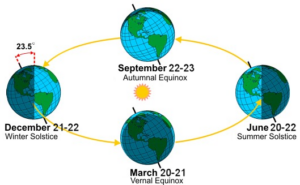
The winter solstice (In Latin, sol, “sun,” and stice, “come to a stop”) is the day of the year with the fewest hours of daylight in the Northern Hemisphere.
In 2021, this occurs for the Northern Hemisphere on Dec. 21 at 9:59 a.m.
As Earth orbits the sun, its axis of rotation is tilted at an angle of 23.5 degrees from its orbital plane. Because Earth’s axis of spin always points in the same direction — toward the North Star — the orientation of Earth’s axis to the sun is always changing as Earth orbits around the sun.
As this orientation changes throughout the year, so does the distribution of sunlight on Earth’s surface at any given latitude. This links the amount of solar energy reaching a location to the time of year and causes some months of the year to always be warmer than others — in other words, the seasons.
On the Northern Hemisphere’s winter solstice, the northern spin axis is pointed away from the sun and latitudes north of the Arctic Circle (66.5 degrees North) have 24 hours of darkness. Meanwhile, the Southern Hemisphere is having short nights and long days.
The time of day that the sun reaches its highest point in its journey across the sky is called solar noon. In early December, true solar noon comes nearly 10 minutes earlier by the clock than it does at the solstice. With true noon coming later on the solstice, so will the sunrise and sunset times.
This discrepancy between clock time and solar time causes the Northern Hemisphere’s earliest sunset to precede the December solstice. The precise date of the earliest sunset depends on your latitude. The latest sunrise doesn’t come on the solstice either. From mid-northern latitudes, the latest sunrise comes in early January.
After the winter solstice, the days get longer, very slowly at first, but at ever larger daily intervals as the March equinox approaches, marking springtime.
Steve Ackerman and Jonathan Martin, professors in the UW-Madison department of atmospheric and oceanic sciences, are guests on WHA radio (970 AM) at 11:45 a.m. the last Monday of each month. Send them your questions at stevea@ssec.wisc.edu or jemarti1@wisc.edu.

